
Panzerschreck was the popular name for the Raketenpanzerbüchse 54, an 88 mm reusable anti-tank rocket launcher developed by Nazi Germany in World War II. Another earlier, official name was Ofenrohr.
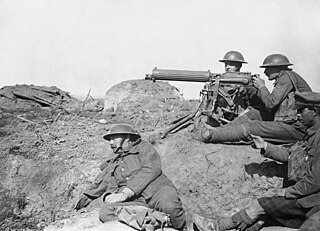
Technology during World War I (1914–1918) reflected a trend toward industrialism and the application of mass-production methods to weapons and to the technology of warfare in general. This trend began at least fifty years prior to World War I during the American Civil War of 1861–1865, and continued through many smaller conflicts in which soldiers and strategists tested new weapons.

The Stielhandgranate was a German hand grenade distinguished by its wooden handle. It was a standard grenade for the German Empire during World War I, and Nazi Germany's Wehrmacht during World War II. Its distinctive appearance led to it being called a "stick grenade", or "potato masher" in British Army slang, and it remains one of the most easily recognized infantry weapons of the 20th century.
A rifle grenade is a grenade that uses a rifle-based launcher to permit a longer effective range than would be possible if the grenade were thrown by hand.
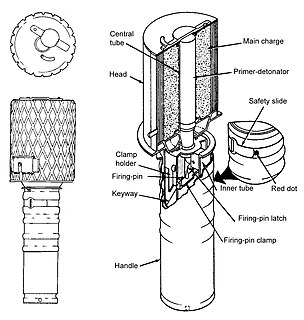
The Soviet RGD-33 is an anti-personnel fragmentation stick grenade developed in 1933.
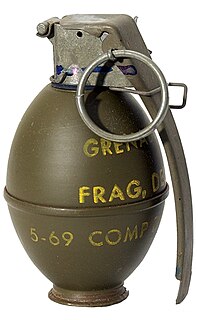
The M26 is a fragmentation hand grenade developed by the United States military. It entered service around 1952 and was used in combat during the Korean War. Its distinct lemon shape led it to being nicknamed the "lemon grenade".
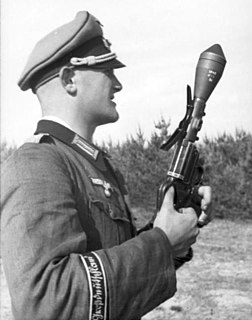
The Sturmpistole (Assault-Pistol) was an attempt by Germany during World War II to create a multi-purpose weapon which could be used by any infantryman. It consisted of a modified Leuchtpistole or flare gun in English which could fire a variety of grenades, including a 600 g shaped charge Panzerwurfkörper 42 which could penetrate 80 mm of rolled homogeneous armor. The idea was not pursued wholeheartedly, and took second stage to the then current anti-tank rifles and later weapon developments, such as the Panzerfaust and Panzerschreck.

The Model 39 "Eihandgranate",M39 or Eierhandgranate 39 was a German fragmentation hand grenade introduced in 1939 and produced until the end of World War II.

The Type 99 Hand Grenade, also known as Kiska grenade by the American Army was an improved version of the Type 97 fragmentation hand grenade used by the Imperial Japanese Army and Imperial Japanese Navy SNLF during World War II.
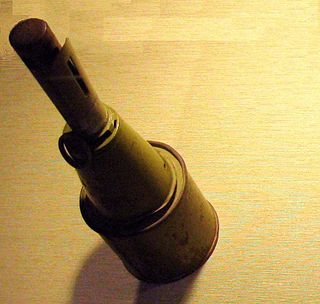
The RPG-43 was a high explosive anti-tank (HEAT) hand grenade used by the Soviet Union during the Second World War. It entered service in 1943, replacing the earlier models RPG-40 and RPG-41. The RPG-43 used a shaped charge HEAT warhead, whereas the RPG-40 used the simpler HE warhead. The RPG-43 had a penetration of around 75 mm of rolled homogeneous armour at a 90 degree angle. Later in the war, it was improved and became the RPG-6.
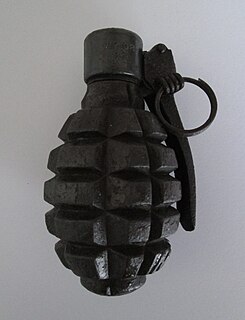
The granat obronny wz. 33 was a fragmentation grenade used by the Polish Army before and during World War II. The shell casing was molded from cast iron and formed into a pineapple-shaped oval, typical of World War I and II-era hand grenades.
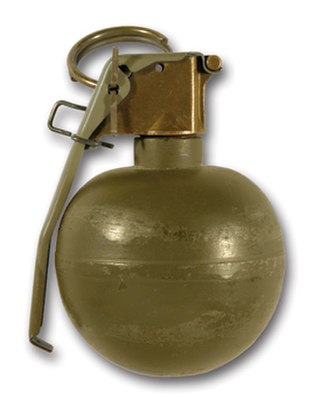
A grenade is an explosive weapon typically thrown by hand, but can also refer to a shell shot out by a rifle or a grenade launcher. A modern hand grenade generally consists of an explosive charge ("filler"), a detonator mechanism, an internal striker to trigger the detonator, and a safety lever secured by a linchpin. The user pulls the safety pin before throwing, and once thrown the safety lever gets released, allowing the striker to trigger a primer that ignites a fuze, which burns down to the detonator and explodes the main charge.
The Model 1914 grenade is a Russian stick concussion grenade that was used during World War I and World War II.
An anti-tank grenade is a specialized grenade used to defeat armored targets. Although their inherently short range limits the usefulness of grenades, troops can lie in ambush or maneuver under cover to exploit the limited outward visibility of the crew in a target vehicle.
The Type 98 Hand Grenade was a fragmentation hand grenade deployed by the Imperial Japanese Army during World War II. The explosive charge contained 3 oz of picric acid.

The Wurfkörper 361 was a grenade that was developed by Germany and used by the Wehrmacht during World War II. The Wurfkörper 361 was designed to be fired from a Leuchtpistole or flare gun in English.

The Leuchtpistole 34 or flare gun in English was introduced into German service before World War II and served throughout World War II.
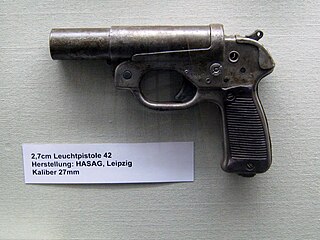
The Leuchtpistole 42 or flare gun in English was introduced into German service in 1943 and served throughout World War II.
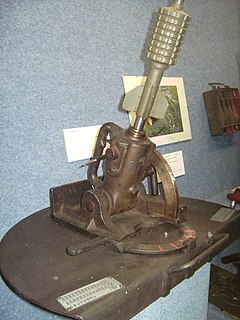
The kleineGranatenwerfer 16 or Gr.W.16(Small Grenade Launcher Model 1916) in English, was an infantry mortar used by the Central Powers during the First World War. It was designed by a Hungarian priest named Father Vécer and was first used by the Austro-Hungarian Army in 1915. In Austro-Hungarian service, they received the nickname "Priesterwerfers". In 1916 Germany began producing a modified version under license for the Imperial German Army.
















